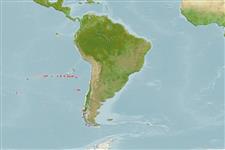Classification / Names
Nomi Comuni | Sinonimi | Catalog of Fishes(Genere, Specie) | ITIS | CoL | WoRMS | Cloffa
>
Argentiniformes (Marine smelts) >
Argentinidae (Argentines or herring smelts)
Etymology: Glossanodon: Greek, glossa = tongue + Greek, anodos = without teeth (Ref. 45335); danieli: Named for Dr. Daniel M. Cohen for his contribution to the knowledge of Argentinidae (Ref. 36002).
Eponymy: Dr Daniel Morris Cohen (1930–2017) was an ichthyologist who was a research associate at the California Academy of Sciences. [...] (Ref. 128868), visit book page.
Environment: milieu / climate zone / depth range / distribution range
Ecologia
marino batidemersale; distribuzione batimetrica 310 - 420 m (Ref. 36002). Deep-water
Southeast Pacific: Chile.
Size / Peso / Age
Maturity: Lm ? range ? - ? cm
Max length : 12.3 cm SL maschio/sesso non determinato; (Ref. 36002)
Short description
Chiavi di identificazione | Morfologia | Morfometria
Spine dorsali (totale) : 0; Raggi dorsali molli (totale) : 11 - 12; Spine anali: 0; Raggi anali molli: 12 - 14; Vertebre: 55 - 57. Distinctive pigmentation on throat and venter; 4 branchiostegals; anus immediately anterior to anal fin base; dentary teeth along more than half the distance from the angle of the gape to the symphysis; absence of densely pigmented spots along the midlateral line (Ref. 36002).
Life cycle and mating behavior
Maturità | Riproduzione | Deposizione | Uova | Fecundity | Larve
Pequeño, G., 1989. Peces de Chile. Lista sistematica revisada y comentada. Rev. Biol. Mar., Valparaiso 24(2):1-132. (Ref. 9068)
IUCN Red List Status (Ref. 130435: Version 2024-1)
Threat to humans
Harmless
Human uses
Strumenti
Special reports
Download XML
Fonti Internet
Estimates based on models
Preferred temperature (Ref.
123201): 2.7 - 2.7, mean 2.7 °C (based on 1 cells).
Phylogenetic diversity index (Ref.
82804): PD
50 = 0.5001 [Uniqueness, from 0.5 = low to 2.0 = high].
Bayesian length-weight: a=0.00363 (0.00163 - 0.00807), b=3.17 (2.98 - 3.36), in cm total length, based on LWR estimates for this (Sub)family-body shape (Ref.
93245).
Trophic level (Ref.
69278): 3.1 ±0.3 se; based on size and trophs of closest relatives
Resilienza (Ref.
120179): Medio, tempo minimo di raddoppiamento della popolazione 1.4 - 4.4 anni (Assuming tmax>3).
Fishing Vulnerability (Ref.
59153): Low vulnerability (10 of 100).
